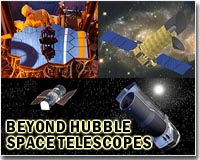 |
Pasadena CA (JPL) Dec 28, 2010 NASA has taken the next step toward a new generation of Deep Space Network antennas. A $40.7 million contract with General Dynamics SATCOM Technologies, San Jose, Calif., covers implementation of two additional 34-meter (112-foot) antennas at Canberra, Australia. This is part of Phase I of a plan to eventually retire the network's aging 70-meter-wide (230-foot-wide) antennas. The Deep Space Network (DSN) consists of three communications complexes: in Goldstone, Calif.; Madrid, Spain; and Canberra, Australia. The 70-meter antennas are more than 40 years old and are showing signs of surface deterioration from constant use. Additional 34-meter antennas are being installed in Canberra in the first phase; subsequent phases will install additional 34-meter antennas in Goldstone and Madrid. The 34-meter beam waveguide antennas are essential to keep communications flowing smoothly as NASA's fleet of spacecraft continues to expand. In addition, the waveguide design of the antennas provides easier access for maintenance and future upgrades, because sensitive electronics are housed in a below-the-ground pedestal equipment room, instead of in the center of the dish. "As a result of several studies, it was determined that arrays of 34-meter beam waveguide antennas were the best solution to long-term continuation of DSN 70-meter capabilities," said Miguel Marina, who manages the 70-meter replacement task force at NASA's Jet Propulsion Laboratory in Pasadena, Calif. "The new antennas are critical communication resources for all current and future NASA missions." NASA expects to complete the building of the first two 34-meter antennas in Canberra by 2016. They will be named Deep Space Stations 35 and 36. Deep Space Station 35 is due to be online in 2014, and Deep Space Station 36 is expected to follow in 2016. In 1958, NASA established the Deep Space Network as a separately managed and operated communications facility to accommodate all deep space missions. This avoided the need for each flight project to acquire its own specialized space communications network. During the Apollo period (1967-1972), these stations supported America's missions to the moon, including the historic first manned landing. The Goldstone antenna, in particular, captured Neil Armstrong's words and sent them on to American television sets while the images came through another antenna. The Deep Space Network is now sending commands to numerous robotic spacecraft, such as NASA's Mars Exploration Rovers, the Spitzer Space Telescope, the Saturn explorer Cassini and the two Voyager spacecraft, which are near the edge of the solar system.
Share This Article With Planet Earth
Related Links Deep Space Network Space Telescope News and Technology at Skynightly.com
 U.K. telescope array yields first images
U.K. telescope array yields first imagesManchester, England (UPI) Dec 22, 2010 An array of radio telescopes in Britain has captured images of a galaxy pouring out a huge jet of matter from the black hole at its center, researchers say. The first images from the new e-Merlin array of linked telescopes show a distant quasar 9 billion light years from Earth, SPACE.com reported Wednesday. Quasars, energy-spewing supermassive black holes at the center of galaxie ... read more |
|
| The content herein, unless otherwise known to be public domain, are Copyright 1995-2010 - SpaceDaily. AFP and UPI Wire Stories are copyright Agence France-Presse and United Press International. ESA Portal Reports are copyright European Space Agency. All NASA sourced material is public domain. Additional copyrights may apply in whole or part to other bona fide parties. Advertising does not imply endorsement,agreement or approval of any opinions, statements or information provided by SpaceDaily on any Web page published or hosted by SpaceDaily. Privacy Statement |